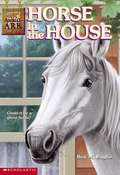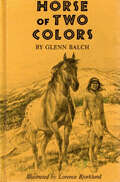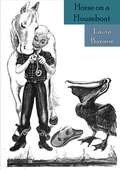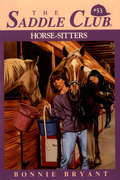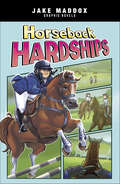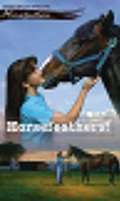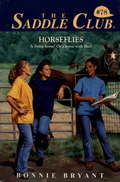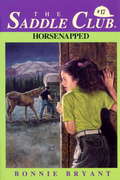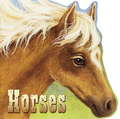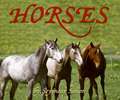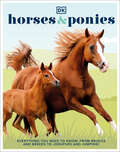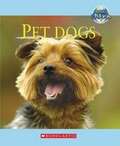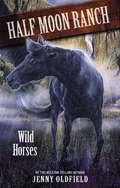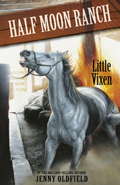- Table View
- List View
Horse in the House (Animal Ark #26)
by Ben M. BaglioMandy and James are sad that their friend Wilfred Bennett has to sell his riding stables. Things get even worse when Sam Western turns the land into a campsite and wants everyone to forget that the stables ever existed.
Horse of Two Colors (Spotted Horse #2)
by Glenn BalchMots-kay, a young boy from the Nimapu Indian tribe, and Pan-sook, his Shoshonee friend, have been enslaved for two years, first by the Eutaw Indians who stole their tribes’ horses, and then by the Spaniards, who traded horses to the Eutaws for them. Now the boys have escaped the Spaniards, taking with them two beautiful horses. Mots-kay had a vision from his god that he should take the spotted horse back to his people. The boys are excited to start their journey to their homelands. But will they make it through the struggles against man and nature that await them along the way?
Horse on a Houseboat
by Laura BannonIn Horse on a Houseboat, Laura Bannon crafts a charming and whimsical tale of adventure, friendship, and a very unusual living arrangement. Perfect for young readers, this delightful story combines humor, imagination, and the joy of unexpected discoveries.The story begins when young Sally and her family move aboard a houseboat for the summer, trading their usual routine for the tranquility of life on the water. But life takes an exciting turn when Sally discovers a horse living on another nearby houseboat. Intrigued by the peculiar situation, Sally befriends the horse’s owner and becomes deeply involved in caring for the animal.As Sally and her new friends navigate the challenges and surprises of houseboat living, they uncover a mystery tied to the horse and its unusual circumstances. Along the way, they learn valuable lessons about responsibility, teamwork, and the bonds that form between people and animals.Laura Bannon’s vivid descriptions and engaging narrative bring the unique setting of the houseboat community to life. With its endearing characters and gentle humor, Horse on a Houseboat is a heartwarming story that celebrates curiosity, kindness, and the magic of childhood adventures.Whether read aloud or enjoyed independently, this enchanting book will capture the imaginations of children and inspire a love for both animals and the open water.
Horse-Sitters (Saddle Club #53)
by Bonnie BryantForming a horse-sitting business to earn some extra money, Lisa, Carole, and Stevie believe that their skills will make the business a breeze, but soon find themselves in way over their heads.
Horseback Hardships (Jake Maddox Graphic Novels)
by Jake MaddoxMaple Run Stables is Leah&’s home away from home. She loves the people, the horses, and the atmosphere. Sadly, Leah&’s family is moving, and the new stable is the exact opposite. Leah feels out of place immediately. Even worse, the other riders bully her about her appearance and size. Leah loses her joy of riding and her self-worth. Leah has all the skills and talent for horse riding success, but will she gain back her confidence in time to prove it?
Horseback Hardships (Jake Maddox Graphic Novels)
by Jake MaddoxMaple Run Stables is Leah&’s home away from home. She loves the people, the horses, and the atmosphere. Sadly, Leah&’s family is moving, and the new stable is the exact opposite. Leah feels out of place immediately. Even worse, the other riders bully her about her appearance and size. Leah loses her joy of riding and her self-worth. Leah has all the skills and talent for horse riding success, but will she gain back her confidence in time to prove it?
Horseback Riding in Action
by Kate CalderThe competitive world of horseback riding starts with caring for horses. Children will learn about the daily care of horses and the basics of horseback riding including equipment, mounting and dismounting, turning, stopping, trotting, and cantering.
Horseback Riding: Explore The World Level E Set
by Trina LawrenceWhat do you know about horseback riding? If you take horseback riding lessons, you will learn a lot about horses. Let’s read all about riding.
Horseback Summer (Horse Crazy #1)
by Virginia Vail Daniel BodeHer best friend, Judy, breaks her leg the week before camp starts, can Emily have any fun without her best friend? While spending the summer at a horse camp, Emily finds the most beautiful palomino horse there. Can Emily fight to keep spoiled Caro Lescaux from taking the horse Emily loves? Picture descriptions present.
Horsefeathers (Horsefearthers #1)
by Dandi Daley MackallEighth-grader Scoop lives with her aunt and grandfather on a horse farm they can barely maintain, but by trusting God and befriending a mysterious and wealthy new neighbor, Scoop finds a way to keep both the farm and her beloved horse Orphan.
Horseflies (Saddle Club #78)
by Bonnie BryantCarole has never considered school one of her favorite things. She isn't a bad student, but she'd much rather spend time with horses than with algebra equations until she starts doing a research project on famous horses in history and literature!
Horsemen of Terror (Left Behind: The Kids #23)
by Tim Lahaye Jerry B. Jenkins Chris FabryWith a deadly judgment from God, Judd's life changes forever. Lionel and the others in Israel try to help, but Judd must endure this trial alone. Vicki and the others at the schoolhouse witness a powerful answer to prayer. Then their worst fears are realized as the Global Community sets a plan in motion to trap believers. Will the kids be forced underground? Follow the Young Trib Force as they struggle to survive and tell others the truth.
Horsenapped (Saddle Club #17)
by Bonnie BryantIt's a horse lover's dream! When snooty Veronica blames her bad performance on her horse, Garnet, and storms out of the ring, Carole follows, fearing Veronica's threat to give away her horse. But horse and rider have disappeared.
Horsenapped! (Storm Cliff Stables)
by Lisa MullarkeyAvery, Bree, Esha, and Jaelyn - the Core Four - are ready for the perfect summer at Storm Cliff Stables! After a bad fall, Bree decides she's never going to ride again. But that doesn't stop this barn rat from returning to camp and learning everything she can to work toward her dream of becoming a vet. Bree cares for the horses as well as all the other quirky, adorable animals at camp. Then one by one, the animals go missing. No one believes Bree until Avery's horse, Sapphire, is the next to disappear. Can Bree and her friends find Sapphire before it's too late? Aligned to Common Core standards and correlated to state standards. Calico is an imprint of Magic Wagon, a division of ABDO.
Horses
by Betina Ogden Monica KullingThere’s a new horse on the farm! He was just born yesterday, but he already weighs 100 pounds and can stand all by himself. Kids will love following this little colt through his first two years of life in this very young nonfiction Pictureback that’s simple and fun enough to be read as a story. Young horse enthusiasts will especially appreciate the horse vocabulary and care information.
Horses
by Checkerboard PressThis is a book about horses and the different types of lives they lead.
Horses
by Seymour SimonIntroduces young readers to horses. In this book the author explains the history, evolution, breeds and cultural ties to horses. <P><P>[This text is listed as an example that meets Common Core Standards in English language arts in grades 4-5 at http://www.corestandards.org.]
Horses & Ponies
by DKThe ultimate visual guide for children passionate about all things equine, covering just about anything and everything horse relatedCalling all horse lovers! This horse book for kids is a one-stop-shop for equine knowledge, from their history, anatomy, breeds, how to care for them, their social significance, and more! Inside the pages of this children&’s book about all things equestrian you will find: • Informative features on all the major horse and pony breeds from the enormous Dutch Draught Horse to the tiny Argentine Falabella • Beautiful images of magnificent horses found across the world • Lessons about the usefulness of horses across different cultures from sport, shows, traditions, and celebrations, to transport, police work, and even shrimp-fishing! • Extensive information and step-by-step instructions on how to ride these magnificent animals and horse care From the difference between horses and ponies to why horses sleep standing up, this comprehensive guide explores every horsey topic you could want to explore! Colorful photographs and pictures on every page include many different horses and pony breeds, from Shetland ponies, shire horses, and thoroughbreds and highlights their importance in our world today.Kids will learn how to care for horses and understand them, covering topics such as grooming a horse, how to muck out a stable, and looking after tack. The book also explores horse skills and will answer questions about riding horses and ponies, such as what dressage is, how to steer a horse, and much more!
Horses (Animals that Live on the Farm)
by Joann Early MackenSimple text introduces the physical characteristics and behavior of horses.
Horses (Nature's Children)
by Isabel OrtonDescribes the history, breeds, colors, markings, uses and care of the domestic horse.
Horses Her Way (Wind Dancers, Book #6)
by Sibley MillerBeautiful Brisa, with her sunset-pink coat and blonde mane and tail, happily sets out to make the world--and everything in it, including her fellow Wind Dancers--as lovely as she is. Sounds like a plan--that only one horse can love!
Horses Of Half Moon Ranch: Diamond Charm
by Jenny OldfieldThis is a recipe for trouble for ranch owner, Sandy Scott. But her daughter Kirstie is undaunted by her mother's warnings. She's at her happiest riding the trails through the tall forests and deep canyons of the Meltwater Range...It's midsummer and a busy time at the ranch. So why does Sandy Scott let Taryn West stay for free? Kirstie soon learns that Taryn's life has recently fallen apart - her mom is missing presumed dead and her dad is the chief suspect. When novice rider Taryn disappears on her favourite horse, Diamond Charm, Kirstie sets off to track her down - before they find themselves battling to save the life of another member of this torn and tragic family ...
Horses Of Half Moon Ranch: Jethro Junior
by Jenny OldfieldJethro Junior is a star jumping horse, tested out by Kirstie over a long, hot summer. The creeks are dry and the threat of forest fires looms large. So when townie campers carelessly discard a lighted match on Eagle's Peak, it's not long before a bush fire rages. First on the scene, Kirstie must ride for help - but there's only one way out, and it involves Jethro jumping the biggest obstacle ever...
Horses of Half Moon Ranch: Book 1
by Jenny OldfieldKirstie is leading a pony trek through Miner's Ridge when a sudden storm causes a landslide. She is trapped alone in Dead Man's Canyon with a herd of wild horses whose leader, a proud black stallion, has been hurt by falling rocks. Cold, wet and alone in the gathering storm - can she find a way out and help the injured stallion?
Horses of Half Moon Ranch: Book 10
by Jenny OldfieldBrad Martin, a famous reining expert, visits Half Moon Ranch with his champion horse, Little Vixen. Kirstie adores the horse but is suspicious of the man - especially when she sees him getting close to her mother. She's heard he's fallen on hard times and is worried he's after a share of the Half Moon profits. Her worry turns to alarm when a sudden fire traps Little Vixen in the barn. Is Martin to blame? If so, why would he put his own horse in danger? Kirstie aims to untangle the truth from the lies...
